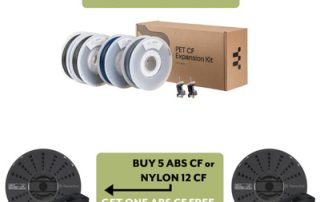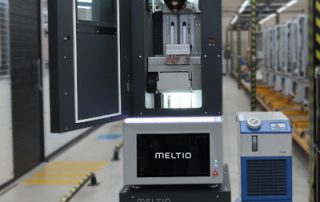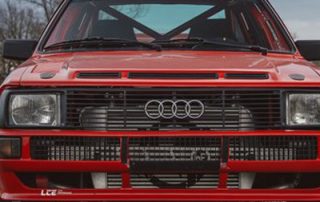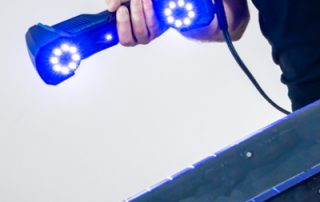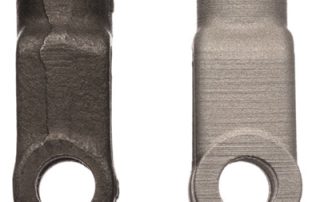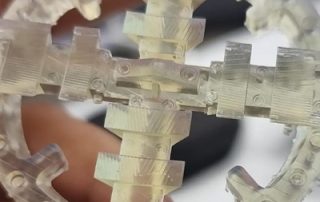UltiMaker 3D Printing Deals You Don’t Want to Miss
Ultimaker Offers 3D Printing Promos that Include Carbon Fiber When it comes to high-quality, reliable, and precise 3D printing, Ultimaker stands tall as a true pioneer. Their cutting-edge technology and user-friendly design have captured the hearts of makers, engineers, designers, and educators worldwide! From now until September 30th, we are running some Ultimaker 3D printing specials that you won't want to miss. These promos involve Carbon Fiber, which is a blend of carbon fibers and a thermoplastic base, resulting in an incredibly strong and lightweight material. This combination grants your 3D-printed objects unparalleled strength, stiffness, and durability. From functional prototypes to robust end-use products, it's a dream come true for engineers and makers alike. Whether you're a new user or an existing user of their platform, there is a deal for you! What sets Ultimaker apart? Superior Print Quality: Ultimaker's printers are renowned for delivering impeccable prints with stunning detail and smooth finishes. From intricate prototypes to functional parts, they nail it every time! Open-Source Freedom: Embrace the spirit of innovation! Ultimaker's open-source platform allows you to tinker, modify, and customize your printing experience. The possibilities are endless! Wide Range of Materials: Whether it's PLA, ABS, PETG, or even Carbon Fiber, Ultimaker printers [...]
Meltio Metal Additive Manufacturing Technology Gets Recognition from US DOD
A reprint from 3D Printing Industry Metal 3D printing company Meltio has been recognized as a “strategic technology partner” by the U.S. Department of Defense (DoD) for its metal 3D printing technology. This move strengthens Meltio’s relationship with the U.S. Army, opening opportunities with other U.S. defense departments and international armies. Additionally, out of 300 participants, Meltio received a fifth-place achievement with Phillips Corp. in the U.S. Army’s xTechInternational program showcasing its unique manufacturing and materials capabilities, positioning them for potential cash prizes and follow-on contracts. “The award we have received is a recognition to Meltio’s professionals and gives reliability to our technology. For us, the military sector is a sector that allows us to bring together all the applications of our disruptive metal 3D printing technology. And it is an opportunity for Meltio to develop a dual application for the civil and military sector. Our technology has the potential to transform different sectors thanks to metal additive manufacturing such as supply chains, logistics, repair and manufacturing of metal parts compared to other conventional techniques such as forging and machining. There are currently many armies in other countries that have Meltio’s metal additive manufacturing technology and we want to stand out as a [...]
Reproducing Legacy Auto Parts with 3D Scanning
The Audi Sport Quattro road and rally car has captivated many automotive enthusiasts since its first launch around 40 years ago. Some even call it the “legend of motorsports”. That’s why two companies passionate about motorsports decided to recreate it with the help of 3D scanning and 3D printing. On one hand, LCE Performance led the way with its long-standing experience in automotive tuning and engine technology. On the other, Downforce Racing brought its carbon-brazed part development services to the table. The teams collaborated to reproduce the Audi Sport Quattro with carbon parts and CFD simulations. Their replica looks stunning: A replicate of Audi Sport Quattro by LCE Performance The main challenge of improving the performance of the racing car In this project, the main challenge was dealing with legacy parts. Many of the race car’s original parts are no longer in production as a result of its lengthy history. Even if second-hand parts were available, they were expensive to buy and difficult to renovate. “They’re 40 years old and look shabby. I pretty much can’t refurbish them at all.” Steven from LCE Performance said. For a company wanting to focus on providing high-quality, durable parts for its customers, these poor [...]
Machining Allowance Inspection with FreeScan UE Pro Metrology 3D Scanner
PT. Meiwa Mold Indonesia (hereby referred to as Meiwa Mold) is a company engaged in die-casting mold manufacturing. Its customer base is diverse, including prominent names like American Toyota, Astra Daihatsu (ADM), HPPM (Honda Precision Parts Manufacturing), and Yamaha. Meiwa Mold recognizes the importance of delivering high-quality molds to meet their customers’ strict requirements. To ensure accurate machining of castings, machining allowances must be tightly controlled. An excessive allowance will raise the machine’s weight and the use of materials, equipment, and energy. That’s why they invested in SHINING 3D’s FreeScan UE Pro metrology 3D scanner for machining allowance inspection, sourced through PT EVOLUSI KREASI INDONESIA, a trusted partner. What challenges did Meiwa Mold face? Before integrating FreeScan UE Pro into their machining margin inspection and analysis process, Meiwa Mold faced a major challenge: scanning medium to large objects. They already had a CMM for small and precision mold inspection and a structured light scanner, but neither was portable enough. With limited space, it was inconvenient to move large and heavy objects. How does the FreeScan UE Pro help Meiwa Mold be more efficient? To address the challenges, Meiwa Mold implemented the FreeScan UE Pro metrology 3D scanner from SHINING 3D. This industrial 3D [...]
What is Bound Metal Deposition (BMD)?
Bound Metal Deposition (BMD) is an extrusion-based metal additive manufacturing (AM) process where metal components are constructed by extrusion of a powder-filled thermoplastic media. Bound metal rods—metal powder held together by wax and polymer binder—are heated and extruded onto the build plate, shaping a part layer-by-layer. Once printed, the binder is removed via the debind process, and then sintered—causing the metal particles to densify. Prevalent metal AM technologies involve melting powder or wire feedstock using lasers or electron beams. While viable, these systems have substantial facilities requirements to accommodate power and safety requirements. Additionally, localized melting and rapid solidification create complex stress fields within parts, requiring rigid support structures to aid heat dissipation and resist shrinkage. As a result, support removal often requires machining. The Desktop Metal Studio System leverages BMD to deliver an office-friendly metal 3D printing solution. There are no loose powders or lasers associated with fabrication. In terms of support removal, parts are printed with their supports which are separated by ceramic interface media (or the Ceramic Release Layer™) that does not bond to the metal. This material disintegrates during sintering, making it easy to remove supports by hand. BMD can be applied to virtually any sinter-able powder that can [...]
3D Printing Changing the Game
How TUM Boring Printed Strong Parts for their Tunnel Boring Machine TUM Boring team in Bastrop, Texas in April 2023. TUM Boring is a student organization from the Technische Universität Munchen composed of more than 60 students originating from 16+ countries. The group came together in 2020 to participate in the Not-a-Boring Competition 2021 from Elon Musk’s The Boring Company (TBC). The student-led team is dedicated to the future of mobility and aims to build one of the fastest micro tunnel boring machines (TBMs) in the world to drive innovation in the tunneling industry. The competition provided the perfect place to see how their project compares to innovations from around the world. After winning the competition in 2021, the TUM Boring team got their hands on a Form 3+ stereolithography (SLA) printer and also got to work with Fuse 1+ 30W selective laser sintering (SLS) printed parts. The newly acquired 3D printing technology significantly improved the team’s work processes. From rapid prototyping to end-use parts, the Form 3+ transformed TUM Boring’s day-to-day operations and helped the team win the second edition of the Not-a-Boring Competition in April 2023. Discover how TUM Boring made use of 3D printing to create strong, durable [...]


